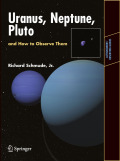
This book is for two groups of people: those who want to study the remote planets with amateur astronomical equipment, and those who are just interested inlearning about our knowledge of the remote planets. The Remote Planets, and How to Observe them is unique in that it gives a completely up-to-date summary of our current knowledge of the remote planets, and also explains how amateur astronomers can contribute to our knowledge of the remote planets. Readers aregiven some inspiring examples of people who, with modest commercially-made equipment, have made important contributions to our scientific knowledge. The observational section goes into great detail, including optical and CCD photometry, occultation measurements, imaging (including stacking and enhancement techniques) and polarization measurements. There are finder charts (from 2010 to 2026), complete with two sets of star-magnitudes in an appendix (one set of magnitudes are for photoelectric photometry and the other set is for visual photometry). Contains a distillation of our current knowledge of Uranus, Neptune, Pluto…and the 10th planet Many new observing projects for different sizes of telescopes (from 4-inch) How to image cloud features on Uranus Describes how to accurately measure and record the brightness of Uranus, Neptune and Pluto Examples of contributions by owners of modest (and some large) aperture telescopesFinder charts for Uranus and Neptune INDICE: Author's Note.- The Uranus System.- The Neptune System.- Pluto andIts Moons.- Observing Uranus and Neptune with Binoculars and Small Telescopes.- Observing with Medium Sized Telescopes.- Observing with Large Telescopes.- Appendix.- Bibliography.- Index.
- ISBN: 978-0-387-76601-0
- Editorial: Springer
- Encuadernacion: Rústica
- Páginas: 230
- Fecha Publicación: 01/08/2008
- Nº Volúmenes: 1
- Idioma: Inglés
